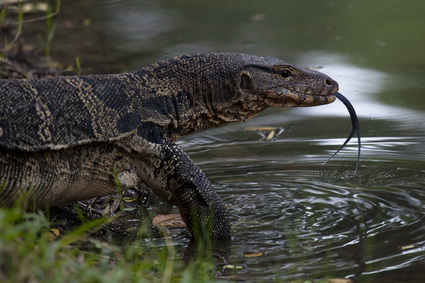Page Visit Log : thai_water_monitor
» Thai Water Monitor Lizard
| Learn Thai | Thai Beaches | Thai Festivals | Thai Baht Rates | Thai Weather | Thai Recipes | Thai Music | Thai Tales | Thai Visa??? | Bangkok Maps |
Thai Water Monitor Lizard - Varanus salvator
If you enjoyed this page then you are sure to enjoy our pages on Wild Cats of Thailand, Thai Mongoose, Thai Primates, Thai Langur, Thai Crocodiles, Thai Turtles, Thai Terrapins, Tokay Gecko, Thai Ants, Thai Ducks, Hornbills, Birds of Prey, Thai Bats, Thai Civets, Thai Snakes, Thai Fish, Fence Lizard, Thai Centipedes, Thai Butterflies, Thai Scorpions, Thai Hornets or the Rhino Beetle.
The most famous place to see water monitors in Thailand is of course Lumpini Park where they roam free, but others such as this monitor lizard is now living with a family in Ratchaburi and even sleeps in their bed, read about it here and this Lizard lives in the drains of a small village in Bangkok.
Monitor Lizards are known to eat fish, frogs, rodents, birds, crabs, snakes and even carrion.
Water monitor's preferred habitat consist of tropical areas, mangrove forests, areas of thick vegetation, and bodies of water, including khlongs and ponds.
In Thailand, all monitor lizards are a protected species and luckily the locals don't eat them as they are often considered as a "bad luck animal".
In Thailand the word for the water monitor is hia, which is also often used as a very offensive term, or as a curse word, so if your talking to a Thai about a water monitor you have just seen be very careful how you explain it.
The monitor lizard is capable of growing to 3.21 metres (10.5 ft) in length, with the average size of most adults at 1.5 metres (4 ft 11 in) long. Maximum weight of Varanus salvator can be over 25 kilograms (55 lb), but most are half that size. Their body is muscular with a long, powerful, laterally compressed tail. Water monitors are one of the most common monitor lizards found throughout Asia, and range from Sri Lanka, India, Indochina, the Malay Peninsula and various islands of Indonesia.
Other monitor lizards found in Thailand include the Black Jungle Monitor, (Varanus salvator komaini) it is smaller than the Bengal Monitor. When adult, its body length will be around 50 centimeters and tail about 60 centimeters in length. Its body is totally black without markings or coloration. It has gray base body, grey-purple tongue.
The Rough-Necked Monitor, (Varanus rudicollis) It is smaller than the Water Monitor. It is dark black with faded strip across its body. It has sharp mouth with short upper scale, big neck with sharp spines like a durian. It has been found in Southern Thailand, Sumatra Island, Bornue Island, Malaysia and Philippine. It likes to eat hen, bird, fish, frog and is able to eat both fresh and decayed food. The Rough-Necked Monitor prefers to live in jungle habitat and find food on land. It can climb trees etc very well. It is known as an agile and fierce animal. The breeding season is January to March and the female will lay her eggs in a hole but she doesn’t brood her eggs which are bred naturally. The junior monitors will find food by themselves.
Red-headed Monitor (Harlegoin Monitor) Varanus dumerilii Its body length reaches between 50-125 centimeters. The younger Red-headed Monitor has coloration ranging from its mouth tip to neck which is orange to deep red in color and will fade as it gets older. There are yellow girdles around its body from its neck to tail. These are the smallest monitors found in Thailand. It is non-poisonous animal. It is generally found in evergreen forest in the southern region of Thailand as well as in Malaysia, Sumatra, Borneo and Singapore.It eats meat and insects. It is slow-moving animal. It hunts for food near its sleeping place. It likes sleeping in tree hollow or rock crevices. It will search for food only if it is hungry, and then resume its sleeping.It lays a clutch of 20 odd eggs which takes 203-230 days of incubation.
Clouded Monitor (Bengal Monitor) Varanus bengalensis. Its body skin is grey-yellow or brown-grey with yellow armor plate or spot covering so it seems totally yellow. It is native in South East Asia including India and Burma. It likes to eat hen, bird, fish, frog, mouse and capable of eating both fresh and decayed food. It isn't fierce like the Water monitor. It prefers to live on tree or around water although they have sometimes have been found in sparse forest and hill far away from streams. It grows up to be an adult in 3 years and lays about 20 eggs during the rainy season.
Hello Unregistered,
What does a water monitor look like? Check out our photos
Photos by Mr Bobcock
 |
 |
 |
 |


